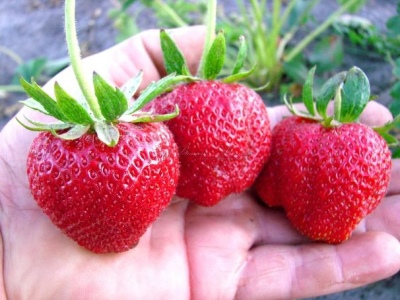
- Taste: sweet
- The size: large and very large
- Weight: 15-30 gr
- Yield rate: medium
- Repairability: Yes
- Appointment: universal
- Berry color: bright red
- Winter hardiness: high
- Berry shape: conical
- Scent: berry, strawberry
Asparagus is a strawberry variety that can be grown without using a greenhouse. But not only for this, the variety is highly valued by summer residents. Thus, Asparagus is characterized by a long fruiting period and easily withstands heat and frost.
Description of the variety
The bush is powerful, medium spreading. The peduncles are located at the level of the leaves, the mustache of the variety is strong, strong, develop in moderation, suitable for seedlings.
Ripening terms
Asparagus is a remontant variety that bears fruit until frost, and the first flowers appear in May.
Yield
Asparagus belongs to the varieties with an average degree of fertility - one bush produces about 5 kg of berries.
Berries and their taste
The fruits are bright red in color and conical in shape. The advantage is the large and very large size of the berries: the weight of each is 15-30 g. The taste is sweet, the aroma is classic berry, strawberry.
The pulp is dense and very juicy, so it is not recommended to store the crop for a long time, it is better to immediately prepare jam or compotes. However, the density of the berries allows them to be transported.
Growing features
This is a universal variety that is distinguished by both drought resistance and winter hardiness, therefore, it is allowed to keep it in a continental climate in the European part. To get a successful harvest, you should not forget to weed the area, moisten the soil in a timely manner (especially during the flowering period) and mulch the planting site.




Site selection and soil preparation
Landing is carried out when the temperature is not lower than +12 degrees.Planting in spring will enable the bush to adapt better and get a harvest in the fall. When preparing for planting, observe the following rules:
choose a sunny place not shaded by trees and other objects;
before planting, loosen the soil well, eliminate weeds, and apply organic fertilizing;
wait until the treated soil settles, and only then plant the plant, leaving the heart at the soil level.
In addition, gardeners recommend planting Asparagus in areas where legumes, crops or marigolds used to grow. It is undesirable to choose a ridge for planting after potatoes, eggplants, tomatoes.

Pollination
The variety is naturally pollinated by insects. When grown in pots, pollination is carried out with a brush.
Top dressing
Nitrogen is usually used as the first top dressing. The culture responds well to rotted manure or mullein. Potash dressings are used before flowering. So, potassium bicarbonate will provide a good fruit ovary and improve the frost resistance of the bush.
In summer, foliar complex fertilizers are relevant. In the fall, it is worth abandoning nitrogen supplements and giving preference to ash or superphosphates.

One of the important techniques in strawberry care is feeding. Regular fertilization guarantees a rich harvest. There are several different ways to feed strawberries, and each of them is designed for a specific period of plant development. During flowering, fruiting and after it, feeding should be different.
Frost resistance and the need for shelter
Asparagus is a winter-hardy variety, but it is still worth protecting the plant in winter. Usually straw, used as mulch, is enough, but it is important to do this at the optimal time: early mulching will lead to damping of the roots, later to their freezing. If grown in the south, this step can be bypassed. When kept in pots, containers are brought into the basement or shed for the winter.

Diseases and pests
One of the main "strawberry" enemies - powdery mildew, as a rule, is not interested in the Asparagus variety. However, the plant can attract roundworms, spider mites, and aphids. In order to avoid damage to the bush by these pests, it is recommended to soak the seedling in a solution of potassium permanganate before planting. Another simple preventive measure against parasites is planting dill next door.

Strawberries are often subject to many dangerous diseases that can seriously undermine their condition. Among the most common are powdery mildew, gray mold, brown spot, anthracnose, and verticillosis. Before buying a variety, you need to inquire about its disease resistance.
Reproduction
The variety is bred with a mustache or by dividing a bush. In the first case, the shoots are carefully placed between the rows, rooted in containers with a nutrient substrate, sockets of the first and second order, and the rest of the whiskers are eliminated.
To propagate the culture by dividing, select strong three-year-old bushes and divide them into 2-3 parts so that a branched root system remains on each lobe. Do not use old specimens with lignified roots for division.



















































































